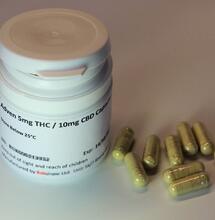Hydro Head To Head

The summer is over! Finally we can crack on with setting up the grow room, safe in the knowledge that our precious plants are no longer susceptible to mother nature punishing us with a heat wave! When you embark on your winter grow and you're eyeing up the options in your local hydro shop, what will you go for? Good ol' fashioned compost or a high tech hydro system?
The summer is over! Finally we can crack on with setting up the grow room, safe in the knowledge that our precious plants are no longer susceptible to mother nature punishing us with a heat wave! When you embark on your winter grow and you're eyeing up the options in your local hydro shop, what will you go for? Good ol' fashioned compost or a high tech hydro system?
The summer is over! Finally we can crack on with setting up the grow room, safe in the knowledge that our precious plants are no longer susceptible to mother nature punishing us with a heat wave! When you embark on your winter grow and you’re eyeing up the options in your local hydro shop, what will you go for? Good ol’ fashioned compost or a high tech hydro system?
Hydroponics can mean less maintenance, easier set ups and a cleaner, compost free growing environment... not to mention quicker harvests and increased yields!
But, it can also mean constant monitoring of nutrients, toppling plants and leaky ceilings!
There are plenty of hydroponic systems out on the market, using many different hydroponic techniques; passive hydro, flood and drain, drip irrigation, DWC, NFT and aeroponics. Let’s take a look at the pros and cons and how they compare to hand feeding.
Passive hydro – What Is It?
| Hobby size NFT system with some nice percy smoke |
Some passive hydro systems involve ‘wicks’ to transfer nutrient solution to the pot, while some of the more advanced systems – like the AutoPot – use valves connected to a header tank to flood the tray that the pot sits in.
Plants grown in a passive hydro set up will have near constant access to water and food and, because most passive systems involve watering from underneath, the top part of the root zone remains highly oxygenated. Therefore, passive hydro can provide far superior results and still be incredibly simple to use and maintain.
The more oxygen, water and nutrients that a plant can absorb, the bigger the yields they will produce.
Passive Pros
| DWC rootball! Awesome! |
Non-recirculating system – the nutrient solution is used by plant, with no run off going back to the header tank. This means that the EC and pH in your tank doesn’t fluctuate and your plants always receive freshly balanced feed. Awesome!
Easily expandable – most types of passive hydro systems that run off a header tank are easily expandable without increasing your workload. This means it’s as easy to water 200 plants as it is to water 20 plants! Modular passive systems are actually used in commercial horticulture for this reason.
Less visits to the grow room – when growing large scale commercial, it’s all about getting maximum yield with minimal risk. To avoid getting caught with your hands dirty, you’ll need to spend as little time in the grow room as possible. Hand watering large scale is a full time job, so that’s a no-no. Active hydro systems will give you the yield, but maintenance duties will mean frequent trips to the grow room to top up the system and adjust EC and pH levels. A passive system fed by a large reservoir can be visited once a week, massively reducing the risk of drawing the attention of the nosey neighbours, local law enforcement or dirty little crop thieves!
Passive Cons
Root zone saturation – constant exposure to nutrient solution means that the lower part of the growing media will always be wet and low in oxygen. This can lead to slow growth and root disease. To counter this, use a light and well aerated medium – like coco - and you MUST ensure that the plants have an established root system before they are put in the system. Hand feed the plants in their pots, make sure that the roots have hit the bottom of the pot and then transplant the pot to the system. A little more work, but worth it.
Growing media still required – yes, it’s a hydro system, but the lack of pumps means that you still rely on the capillary action of a growing medium to transfer moisture through the root zone. You’ll still be carrying bags from the car to the grow room… but at least your plants are still fed in a power cut!
Flood and Drain – What Is It?
| Nice flat canopy from the passive AutoPot system |
During the flood period the roots of the plants are submerged which allows them to take up all the water and nutrients they need. All stale air is expelled from the root zone then, as the solution drains away, fresh oxygen is pulled back into the root zone. As the plants grow larger, you increase the number of floods per day.
The amount of nutrient solution used is easily measured and this allows experienced growers to tailor feeding schedules to get the optimum yields from their plants.
Flood and Drain Pros
It’s really adjustable - at its most simple, it can be a way to just keep your pots automatically watered, but for the more experienced grower it is the method that offers the most amount of choice as you can amend the number of flood periods per day and how long each flood lasts. This way you can tailor the system to your own growing environment – because everyone’s grow room has a different humidity, temperature and airflow - and get the maximum yield from you plants.
Root zone completely re-oxygenated several times a day - during the flood period, air is completely forced out of the root zone and fresh oxygen is pulled back in. The more oxygen you can get into the root zone, the healthier the plant.
No build-up of nutrient salts - any nutrients not used by the plants just drains back into the reservoir, instead of building up at the bottom of the pot. A build-up of nutrient salts will stunt growth as it causes certain nutrients to be ‘locked out’.
Flood and Drain Cons
Complicated – the modular Flood and Drain systems can be a bit of a nightmare to set up and maintain. Although it’s great that you can position modules where you like, setting up does involve tinkering with lots of pipework and washers. Best plan is to place the pots where you want them first, then lay your pipework around them.
Misunderstood – not really the fault of the systems, but nobody really seems to use Flood and Drain tables in the UK. However in the US… every fucker uses them! They’re incredibly simple to set up and manage, plus you can still use pots and coco with them. Come UK grow shops… catch up!
Too tall for tents – most of the Flood and Drain tables on the market, sit on a stand with a large reservoir underneath them. Unfortunately, the larger tables need larger reservoirs to flood them and this takes up precious head room in a grow tent. Luckily some manufacturers now produce low level tables with integrated reservoirs… ask your grow shop for more info.
Drip Irrigation – What Is It?
There are many types of drip irrigation - pot drippers, drip ring systems, slab drippers - but they all work on the same principle. Your plants are started in a growing medium and a dripper is placed into, or suspended over, the medium. The dripper is attached to a dripper line, which is in turn attached to a pump.
You keep your nutrient solution in a reservoir and, at periods set on a timer, nutrient solution is pumped from the reservoir, through the dripper line and delivered to each plant via the dripper.
The nutrient solution works its way through the medium and over the roots of your plants, draining out through the growing medium and drawing oxygen into the root zone. Feeding small doses of water and nutrient at frequent periods throughout the day ensures that the growing medium will not get totally saturated, so there will always be plenty of oxygen present around the roots of the plant.
| Use a line cleaner to stop blockages in your hydro system |
As plants mature, the number of feed periods are increased to achieve optimum growth and yield. It’s the preferred commercial method of crop cultivation for longer term crops like; tomatoes, peppers and cucumbers.
Drip Irrigation Pros
Totally flexible - drip irrigation offers something for every grower, from the soil lover who just wants to keep their pots automatically watered, to the hydro expert who is looking to measure the nutrient uptake of their crop on a daily basis and devise the perfect feeding schedule for their own growing environment. You can use it with any growing medium on any scale.
Good mix of food, water and oxygen - when plants are fed little and often, the medium is never saturated and starved of oxygen. Hand watering plants once every few days can result in water-logging where all of the oxygen is forced out of the root zone and the roots take ages to uptake the moisture from the medium.
It’s far less work than hand feeding – just mange one nutrient solution tank for all of your plants and top it up every couple of days – far easier than hand watering.
Drip Irrigation Cons
| Nice tree in a drip ring Flo-Gro system |
Blockages – dripper line has a small internal diameter and over the course of a full grow – 8 to 14 weeks, depending on strain – there is the potential for these dripper lines to become blocked, particularly if you use concentrated, mineral nutrients and stimulators (and if you want the biggest amount of bud possible, you will be!). Adding an anti-blocking agent – like Keep It Clean or D-Block - to your reservoir will keep things flowing freely.
DWC – What Is It?
Deep Water Culture (DWC) is a growing method whereby the roots of the plant are constantly submerged in a highly oxygenated nutrient solution (hence the term; ‘Deep Water’). Very little growing medium is used, other than a propagation cube and a few clay pebbles. The initial root ball of the plant is started in a net pot, suspended above a reservoir or bucket. The roots of the plant grow out of the pot and into the reservoir where there is constant availability of water, nutrient and oxygen; delivered via an air pump.
Plants that are grown in Deep Water Culture have a huge supply of nutrient solution and oxygen. When executed correctly, amazing results are possible.
DWC Pros
| Roots in an aeroponic cloner |
Turbo charged yields – DWC systems offer massive exposure of the plants roots to water, nutrient and oxygen. They literally sit in a bath of heavily oxygenated food! Big yields, here we come!
No feeding schedules to work out – plant roots have constant exposure to all of the water and nutrient they require, they uptake whatever they need, exactly when they need it. No need for a timer.
DWC Cons
Noisy – any system powered by an air pump will create a buzzing sound. One system on its own is ok, but put 4 in your tent and it’ll drive you crazy! Try hanging them on an elastic bungee cord to cut down the vibrations.
Cleaning the reservoir – to perform cleaning duties; lift the lid and plant off the system and transfer it onto a second bucket. Sound easy? Try doing it with a 5 foot plant covered in bud and a root ball that doesn’t want to fit back into the bucket! It’s a two man job.
NFT – What Is It?
NFT stands for Nutrient Film Technique, where nutrient solution is pumped onto a tray or, in commercial situations, a gulley to create a very shallow, slow moving film that flows through the roots of the plants providing them with all the elements they need.
The roots of the plants grow into the solution and fill the tray or gulley, forming a large root mat.
This constant access to water and nutrients, combined with an abundant supply of oxygen to the roots, means plants grown in NFT develop very rapidly and produce significantly larger yields than soil grown plants. This is why it is a preferred method in commercial horticulture for quick cropping plants like lettuce and herbs.
NFT Pros
Faster growth rates and bigger yields – because plants have constant access to what they need, they grow quicker and yield more. The accelerated growth rates shorten the veg cycle, so you get more crops per year and, when dialled in correctly, you can harvest significantly higher yields than conventional compost growing.
It’s simple – as hydro systems go, it’s a piece of piss to set up. There are no complicated delivery systems or feeding schedules to calculate. Plus, because the system is always ‘on’ and plants just take what they need, there’s no chance of over or under feeding.
Clean to use and produces minimum waste – no compost means there’s no chance of soil bourne pests and no heavy bags of medium to carry around when setting up or after chopping down. Just roll up the root mat and throw it away!
NFT Cons
Root disease – talk to any seasoned grower about NFT and they’ll all tell you the same thing; fantastic results BUT watch out for Pythium! As the roots of the plants are constantly bathed in water it’s easy for root disease to take hold. High temperatures can bring on an attack in a matter of hours. Use a heater or chiller to maintain a steady root temp of 20-22®C and apply root treatments – Pyth Tabs or Regen A Root - at the first sign of trouble.
Constant monitoring – the constant access to the nutrient solution allows the roots to constantly feed. As they feed, the balance of nutrients in the solution changes and the EC fluctuates. You need to be on your game with monitoring EC – and pH for that matter – otherwise your plants will suffer deficiencies. For best results, change the solution a minimum of once a week, or more often as the plants are flowering.
Toppling plants – NFT provides no support to the plant structure, so once plants begin to flower they become top heavy and topple over. Plan your supports before the flowering stage and have your pea netting and yoyos at the ready.
Aeroponics – What Is It?
Aeroponics is a growing method whereby the roots of a plant are suspended in air and constantly sprayed with a mist of nutrient solution. No growing medium is used, other than a propagation cube if the plant was started from seed. The roots of the plant grow into a chamber or channel where they are fed by misters, sprinklers or spray heads that deliver the nutrient solution via a pump.
Aeroponics can be used to grow plants full cycle and also produces excellent results when used to propagate clones.
Plants that are grown aeroponically have constant access to nutrient solution and oxygen; taking up much more water and nutrients than plants that are hand watered. The more oxygen, water and nutrients that a plant can absorb, the bigger the yields they will produce.
Aeroponics Pros
| The low level flood and drain table |
Faster turnaround of clones – aeroponic cloners are the fastest way to root a cutting. Transplanting within 5-6 days isn’t unheard of and some of the larger cloners fit over 100 cuttings!
Healthy root zone – no growing medium is required whatsoever, not even a propagation cube, this means a reduced risk of soil borne pests and disease.
Aeroponic Cons
High performance, high risk – aeroponic growing, done right, is pretty much the pinnacle of plant performance. The yields achievable are stupendous! However, running an aeroponic system is a bit like driving a Ferrari full pelt down the road… amazing performance but one small mistake and your fucked! The lack of growing media around the roots means that the plants are highly susceptible to over feeding, temperature, pH fluctuations and root disease. Whilst the systems themselves need a lot of maintaining; a power failure knocks your pump off or a sprinkler stops working and your plants are dead in hours. But for the smaller scale hobby grower, the take is worth the risk!
Happy growing!



